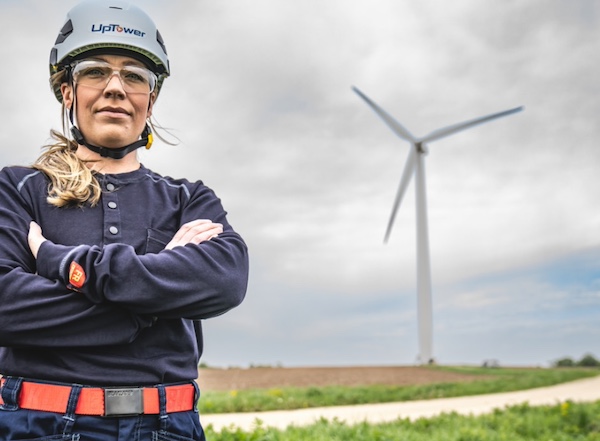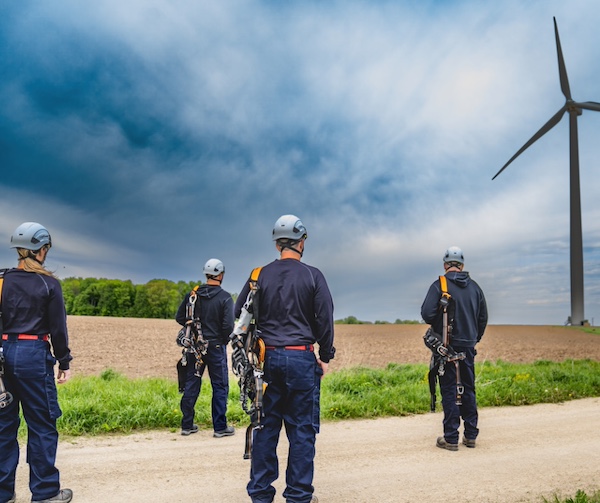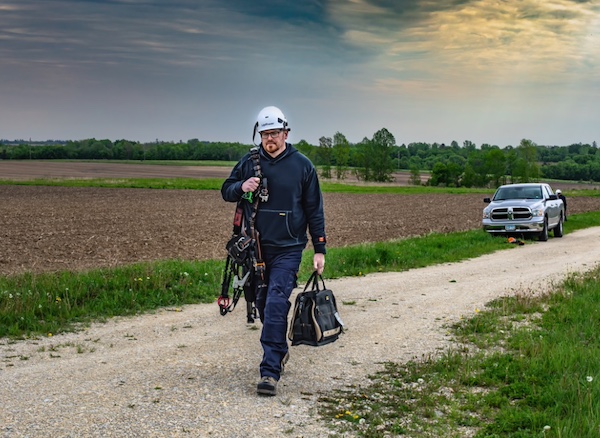A Safe Passage Through the Winds: Turbine site visits
The allure of wind turbines is undeniable. For those fortunate enough to visit these engineering marvels, it’s an experience filled with awe and learning. However, the magnificence of these structures comes with inherent risks, making safety an absolute priority. The prior safety training of participants in courses like ‘Limited Access’ (a standardized course approved by The Global Wind Organization) plays a crucial role in ensuring visitor safety during these visits, both onshore and offshore.

1. Pre-visit preparations
Understanding Wind Turbine Operations
A basic understanding of how wind turbines work will enhance the visit experience. These turbines are complex assemblies involving high-speed mechanical and electrical components that transform wind kinetic energy into electrical power.
Health and Fitness Considerations
Given the physical nature of the experience, a basic health check is essential. Climbing stairs and navigating confined spaces are common during the visit. Those with heart conditions, vertigo, claustrophobia, or mobility issues should consult their doctor and the visit operator in advance.
2. The use of a Limited Access program
Emphasis on Safety Training
A Limited Access or similar safety training program equips visitors with essential skills, such as how to use personal protective equipment (PPE) effectively and behave safely during supervised visits. This program underlines the criticality of understanding safety protocols in wind turbine environments.
PPE and Safety Briefing
Upon arrival, visitors should receive a safety briefing, which is an integral to the safety program and site visit. This briefing will cover site-specific hazards, emergency procedures, and proper use of PPE.

3. On-site safety protocols
Weather and Environmental Awareness
Wind sites, especially those offshore, are subject to rapidly changing weather conditions. It should be understood that all visits are weather dependent, and may be rescheduled if site conditions pose a risk.
Inside the Turbine: A Step-by-Step Approach
Navigating a turbine requires vigilance. Visitors should be instructed on how to move safely within the turbine, and always proceed with an experienced guide who can provide directions and recognize potential hazards.
Electrical Safety Compliance
Adhering to NFPA 70E guidelines, visitors must maintain a safe distance from electrical panels and machinery, a rule strictly enforced during the visit.
4. Emergency procedures and reporting
Preparedness for Emergencies
Knowledge of emergency exits and procedures is vital. The site should make sure all visitors are well informed about these aspects, contributing to a safer environment.
Incident Reporting
Immediate reporting of any incidents or near-misses to the site supervisor is essential for maintaining a safe visit environment.
5. Post-visit reflections
Debrief and Feedback
A post-visit debrief allows visitors to discuss their experience, offer feedback, and reinforce learning, an integral part of continuous safety improvements for any safety-focused wind site.
Carrying the Message Forward
The knowledge gained isn’t just for the duration of the visit; it’s part of a broader commitment to safety and understanding in the field of renewable energy.

Conclusion
A visit to a wind turbine is a unique blend of adventure and education. The site’s requirement of prior safety training (like a Limited Access Course) for visitors is key to ensuring that they not only enjoy this experience, but do so with the highest regard for safety. It encapsulates the essence of responsible visiting – where excitement and learning go hand in hand with adherence to strict safety protocols.
By following these guidelines, visitors can immerse themselves in the fascinating world of wind energy while taking responsibility to ensure all persons (workforce or visitors) are well-equipped to navigate the complexities and potential hazards of a wind turbine environment. This careful balance of safety and exploration is crucial for fostering a deeper appreciation and understanding of wind turbine generators.
Remember, a journey inside a wind turbine is more than just a visit; it's an educational adventure into the heart of sustainable energy. It serves as a vivid reminder of the power of the wind harnessed through human ingenuity, and the importance of respecting both the technology and the natural forces it utilizes.
By embracing the safety responsibilities of all who take part in learning about and exploring wind turbine generators, visitors become ambassadors of renewable energy, carrying with them not just memories of an extraordinary experience, but also an awareness of the importance of safety in harnessing wind power. As we step inside these giants of the wind, let us do so with a sense of responsibility and wonder, mindful of the delicate balance between us and nature.
Katie Bielefeld is Growth Strategist at the Renewable Training Center (RTC). RTC provides training solutions for the wind energy sector, offering a comprehensive range of courses, including GWO (Global Wind Organization) training in partnership with TSL & the Iowa Lakes Community College, First Aid/CPR, Working at Heights, and NFPA 70E.
RTC-USA | rtc-usa.com
Author: Katie Bielefeld
Volume: 2024 March/April








